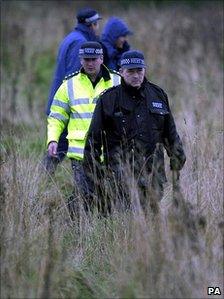Hidden graves found using chemical 'sniffer' technology
- Published

Pinpointing a suspected gravesite is no easy task
A "sniffer tube" could replace dogs in the arsenal of tools to locate hidden graves, say researchers.
A new technique uses a long tube to quickly sample the air above suspected gravesites.
The specially coated tube can spot tiny amounts of a chemical linked to the breakdown of animal remains, up to months after the remains are buried.
The research is published in Forensic Science International and highlighted in New Scientist magazine.
The task is to outperform the premier detector of hidden explosives, drugs, or humans alive or dead: the sniffer dog. But as much as dogs can be trained, it remains unclear what exactly they perceive.
"We're not really sure what the dogs are sniffing or what they're focusing on," said Tom Bruno of the National Institute of Standards and Technology (Nist) in the US.
"And dogs can be difficult to control, and uncertain," he told BBC News. "Recently we've come to think dogs aren't sniffing an explosive, but cyclohexanone, a chemical used to re-crystallise the explosive.
"What if the bomb makers switch to using another chemical instead?"
In order to win out over the dog's abilities in finding hidden graves, Dr Bruno and his colleague Tara Lovestead adapted their "headspace analysis" technique, originally developed to detect explosives and more recently adapted to sniff out food spoilage.
Shedding light
At the heart of the approach is the use of a long tube lined with two materials: alumina, a porous but tough material that soaks up molecules from the air, and ninhydrin, a molecule that binds both to alumina and to the clues indicating a hidden grave.
Almost all animal tissue is made up of proteins, which after death break down into constituent parts, some of which end up free in the air. In mammals, the structure of many of these decomposition products - with evocative names such as cadaverine - is known.
When these products encounter ninhydrin, a particular bond is formed - a bond that absorbs light of a particular colour.
At one end of the tube is a source of ultraviolet light and at the other a detector. The more decomposition products that settle in the tube, the more light gets absorbed along the way; the light level is then an indirect measure of the presence of decomposing flesh.
To set up their "gravesites" to be tested, the researchers placed rat cadavers on top of or buried underneath soil in a number of compartments. Other compartments were left with soil only.
Their detection technique accurately spotted the presence of the cadavers, at times ranging up to 20 weeks after burial - the decomposition process eventually exhaust the supply of proteins.
Dr Bruno says that the team will carry on applying the technique to a range of "sniffing" problems, and that they are already in discussions to commercialise the idea.
It may be some time before the technique can routinely outperform a dog's nose, but may become indispensable for cases in which a grave may be hidden beneath more than just soil.
"In large areas, it would be a supplement to other methods or dogs," Dr Bruno said.
"But in small areas, or if you suspect there's something buried under a concrete slab, it's probably the best way."